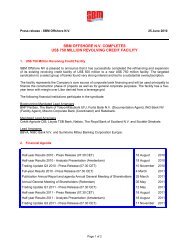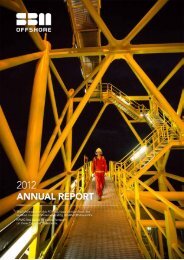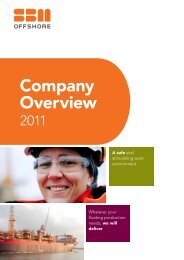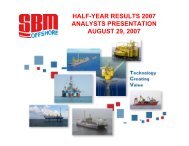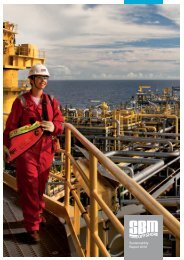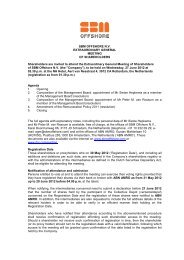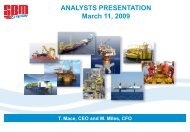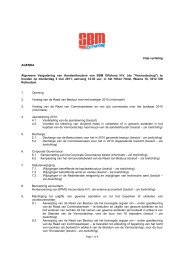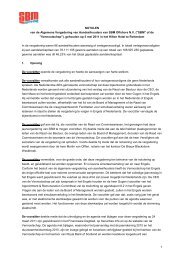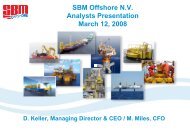Annual Report 2010 - SBM Offshore
Annual Report 2010 - SBM Offshore
Annual Report 2010 - SBM Offshore
Create successful ePaper yourself
Turn your PDF publications into a flip-book with our unique Google optimized e-Paper software.
accounting and the risk management objective and<br />
strategy for undertaking the hedge. The documentation<br />
includes identification of the hedging instruments, the<br />
hedged item, or transaction, the nature of the risk being<br />
hedged and how the Company will assess the hedging<br />
instrument’s effectiveness in offsetting exposure<br />
to changes in the fair value of the hedged item or cash<br />
flows attributable to the hedged risk. Such hedges are<br />
expected to be highly effective in offsetting changes<br />
in the fair value of the hedged item or cash flows and<br />
are assessed periodically to determine that they actually<br />
have been highly effective throughout the financial<br />
reporting periods for which they were designated. The<br />
Company uses cash flow hedges and hedges of net<br />
investments in a foreign operation.<br />
Hedges which meet the strict criteria for hedge<br />
accounting are accounted for as follows: the effective<br />
portion of the gain or loss on the hedging instrument is<br />
recognised directly in equity, while the ineffective portion<br />
is recognised in the income statement. Amounts<br />
taken to equity are added or deducted from the recognised<br />
value of the hedged item upon its recognition and<br />
to the income statement when the hedged transaction<br />
affects the income statement. When a hedging instrument<br />
expires or is sold, or when a hedge no longer<br />
meets the criteria for hedge accounting, any cumulative<br />
gain or loss existing in equity at that time remains in<br />
equity and is recognised when the forecasted transaction<br />
is ultimately recognised in the income statement.<br />
If the forecasted transaction is no longer expected to<br />
occur, amounts previously recognised in equity are<br />
transferred to the income statement.<br />
The fair values of various derivative financial instruments<br />
used for hedging purposes are disclosed in the<br />
note 18 - Derivatives financial instruments. Movements<br />
in the hedging reserve in equity attributable to shareholders<br />
are shown in the note 20 - Equity attributable to<br />
shareholders.<br />
Cash and cash equivalents<br />
Cash and cash equivalents consist primarily of highly<br />
liquid investments, such as bank deposits. Bank overdrafts<br />
are shown in borrowings and bank overdrafts as<br />
part of current liabilities in the balance sheet.<br />
Financial Review / Financial Statements <strong>2010</strong><br />
Share capital<br />
Ordinary shares and preference shares are classified<br />
as equity. Incremental costs directly attributable to the<br />
issue of new shares are shown in equity as a deduction,<br />
net of tax, from the proceeds.<br />
When any group company purchases the Company’s<br />
equity share capital (treasury shares), the consideration<br />
paid, including any directly attributable incremental<br />
costs (net of income taxes) is deducted from equity<br />
attributable to the Company’s share holders until the<br />
shares are cancelled or reissued. Where such shares<br />
are subsequently reissued, any consideration received,<br />
net of any directly attributable incremental costs and<br />
the related income tax effects, is included in equity<br />
attributable to the Company’s share holders.<br />
Borrowings (long-term loans and other liabilities)<br />
Borrowings are recognised initially at fair value.<br />
Borrowings are classified as current liabilities unless the<br />
Company has an unconditional right to defer settlement<br />
of the liability for at least 12 months after the balance<br />
sheet date. As of 2007 the attributable transaction<br />
costs are capitalised in financial assets and amortized<br />
to net interest expenses based on the expected<br />
repayment period of the debt for which the costs were<br />
capitalised. Before 2007 the attributable transaction<br />
costs were capitalised in the related property, plant and<br />
equipment. Reference is made to the note 12 - Other<br />
financial assets for details of capitalised transaction<br />
costs.<br />
Deferred income tax<br />
Deferred income tax is recognised, using the liability<br />
method, on temporary differences arising between<br />
the tax bases of assets and liabilities and their carrying<br />
amounts in the financial statements. However,<br />
the deferred income tax is not accounted for if it<br />
arises from initial recognition of an asset or liability in<br />
a transaction other than a business combination that<br />
at the time of the transaction affects neither accounting<br />
nor taxable profit or loss. Deferred income tax is<br />
determined using tax rates (and laws) that have been<br />
enacted or substantially enacted by the balance sheet<br />
date and are expected to apply when the related<br />
deferred income tax asset is realised or the deferred<br />
income tax liability is settled.<br />
<strong>SBM</strong> <strong>Offshore</strong> – <strong>Annual</strong> <strong>Report</strong> <strong>2010</strong> 123



